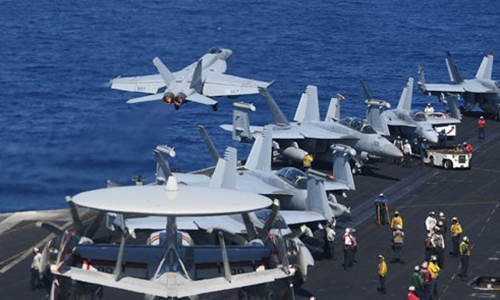US churns troubled waters and waves in Asia-Pacific region
By Chen Xiangmiao Source:Global Times Published: 2020/6/23 18:03:41

A US FA-18 Hornet fighter jet flies past fighter jets and E-2C Hawkeyes during a routine training aboard US aircraft carrier Theodore Roosevelt in the South China Sea on March 31. Photo: AFP
A report entitled "The US Military Presence in the Asia-Pacific 2020" was released by the National Institute for South China Sea Studies in Beijing Tuesday. Why does a report on the US military presence in the Asia-Pacific region have to be released? Since 2010, the US has been hyping the so-called China's militarization in the South China Sea. It sensationalizes that China's military power has continued to extend and radiate into the Indian Ocean, the Western Pacific region, and Northeast Asia. Hence, a study of US military actions in the region is required.
We want to analyze current status and development of the US military power in the entire Asia-Pacific region by providing objective, detailed and accurate data (published by the US itself) for the international community. Through our analysis, we find that the military strength of the US in the Asia-Pacific region is still the strongest and is still increasing. It is the US, not China, that promotes the militarization of this region.
Why did we choose to release the report on the US military presence at this moment? After Donald Trump took office in 2017, the security strategy of the US in the Asia-Pacific region has undergone major adjustments. The most obvious one is to shift from the Asia-Pacific rebalancing strategy of the Obama administration to the Indo-Pacific Strategy. The Indo-Pacific Strategy not only is concerned with the deployment of military forces, but also emphasizes the construction of a network of regional security frameworks. These are different from the bilateral military partnership frameworks built by the US during the Cold War. This is the most obvious feature of the Indo-Pacific Strategy.
Trump will soon have been in office for a full term, and the US will usher in a general election in November. We chose to release the report during this period because we also want to make a summary of Trump's military strategy and deployment in the region during his first term.
Recently, many scholars are discussing whether large-scale military conflicts between China and the US will break out in the Asia-Pacific region. Whether the competition between the two countries in the region will lead to military conflicts does not depend on China, but on the attitudes of the US hawks toward China. China hopes to live in peace with other countries, including the US, and to maintain regional and world peace and stability.
As the two largest economies in the world, China and the US both have a powerful military and nuclear weapons. A war between the two countries is the last thing that most people in the world would like to see. However, considering the deep hostility of some US anti-China hawkstoward China, it cannot be ruled out that they harbor extreme ideas about a war between the two countries.
If China and the US want to maintain good military relationship, it is necessary for both countries to invite other major powers to negotiate on critical regional security issues in order to coordinate regional security and establish an effective framework for maintaining peace and stability within the region. Since 2017, many multilateral frameworks have been almost destroyed by Trump's unilateral "withdrawal." This has directly led to the loss of various opportunities for negotiations on regional security issues
The US has been increasing its military strength in the Asia-Pacific region and intervening in regional issues. In response to this, China should make efforts from the two aspects as below.
First, China should shelve and ease conflicts with its neighboring countries that it has disputes with in order to mitigate risks of US interference in Asia-Pacific affairs. Once the situation in the South China Sea is stabilized, the US will find less room to intervene in the Asia-Pacific affairs. At the same time, it is necessary for China to conduct bilateral negotiations on controversial issues with Japan, India and other countries in order to prevent the disputes from being intensified and keep situations from getting out of control.
Second, China must also demonstrate its military power when it is necessary. When confronted with provocations from the US over the South China Sea issue and Taiwan question, China has to send a signal to the US that if the US continues to make waves in the region, it will only cause regional turmoil which will be detrimental to both countries.
The author is an assistant research fellow, National Institute for South China Sea Studies. opinion@globaltimes.com.cn
RELATED ARTICLES:
Posted in: VIEWPOINT